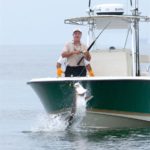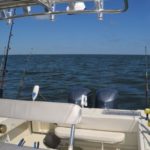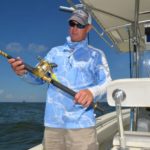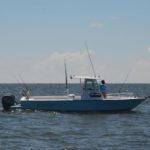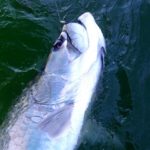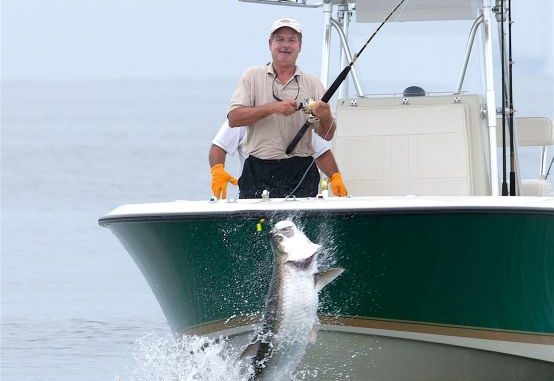
Don’t overlook the Gulf’s best and meanest acrobats
“There are exceptions to everything we are going to tell you today and tomorrow.”
The speaker was a dignified man, but one with a serious problem. David Prevost was a tarpon addict.
He is also the current state record holder for tarpon, a 246.6-pound monster he caught in October of 2015.
“The exceptions are what keeps us coming back; the mystery of it. I’ve seen being out here all day and not catch a fish, then at 3 o’clock, they are everywhere.”
We were talking tarpon in Prevost’s Grand Isle camp. With him there were Jeff DeBlieux, his partner the day he caught the record fish, legendary tarpon fisherman Lance “Coon” Schouest, and Schouest’s brother Joe “Dookie” Schouest, Jr.
I would be on the water the next day with Prevost and DeBlieux. Coon Schouest would be fishing on his own boat with a charter customer.
Sixty-one-year-old Prevost, a consulting CPA, has been fishing tarpon since 1980, after fishing the first time with Ronnie Roger, who he described as “one of the old time tarpon fishermen.”
“The excitement of the jump and the thrill of catching them attracted me,” he smiled. “I always told my wife that I wanted to catch the state record. The day I did, Jeff and I caught 8 fish and it was the last one.
“I measure the girth of a tarpon with a tape around its belly to estimate weight. It has to be 43 or 44 inches to be over 200 pounds. I made up my mind not to boat a fish unless it taped as a state record. This one measured 46 inches.
“Last week, I released two, one I estimated at 205 pounds and the other at 215 pounds. I fish for tarpon from the end of July to the end of October and catch between 40 and 50 a year.
“I fish speckled trout in April and May and from November to January. In June, I fish red snappers during the big 9 days (3 days this year) we get.”
DeBlieux, a part-time waterfowl taxidermist since retiring from professional land surveying, started tarpon fishing in 1977 with a neighbor who took him, his brother, and his father on a trip.
“I’ve been hooked ever since,” he grinned. He most often fishes with his brother on his 22-foot Shamrock, but will make a couple of trips a year with Prevost.
“All the serious tarpon fishermen know all the others,” he said.
“There are about 20 serious boats in Louisiana,” noted Prevost, “with maybe another 20 casual boats that go once or twice a year.”
“Ten are real serious,” added DeBlieux, “Diehards!”
Prime waters
Louisiana has a complex and varied coastline, and tarpon can be found in much of it, including inshore lakes like Pontchartrain. But modern tarpon fishermen concentrate their efforts in proven hotspots.
Closest to Grand Isle, Prevost’s base of operations, is Grand Bayou, where Prevost and DeBlieux began their day. In spite of the name, there are no bayous out here. Grand Bayou is inshore.
These are offshore waters, approximately 7 miles out of Barataria Pass and in the 35- to 40-foot depth range. The water tower on Grand Isle was barely visible. Prevost rated it as a good September-October spot.
The west side of the Mississippi River’s Southwest Pass is another prime location. There, fishermen concentrate on the “golden triangle” (DeBlieux’s term), framed on its corners by 3 oil platforms: West Delta Block 27 (Hotel Rig), West Delta Block 58, and West Delta block 61.
It offers the advantage of calmer waters, being sheltered by the long arm of Southwest Pass reaching into the Gulf of Mexico. To the east is the 10- to 12-square mile area southwest of West Delta Block 84. Peak productivity near Southwest Pass is August.
Other frequently fished spots are off the southeast side of South Pass, East of Southeast Pass, and east of Northeast Pass.
The various spots allow tarpon fishermen to take advantage of wind direction to get the calmest conditions possible.
No matter where the fishing is done, best fishing depths are from 30 to 50 feet. The shallowest that Prevost has caught tarpon was 12 feet deep.
The problem with fishing in shallow waters is that Coon Pops, Prevost’s preferred lure, are heavy, weighing in at 2 to 3 ounces and will rapidly sink to the bottom.
Surprisingly, dingy waters are best for tarpon fishing. “I’ve seen fish in clear water and I’ve caught fish in clear water,” said Prevost. “But they seem to prefer dingy water, probably because that’s where the bait fish stay. I’ve even caught them in brown river water.”
Weaker tides, in the .7- to .8-foot range, rather than stronger tides, are best. With strong tides, tarpon do not seem to appear on the surface as frequently.
Rigging up
The simplest thing in rigging up for tarpon is lure selection. Virtually every tarpon fisherman in Louisiana uses Coon Pops, invented by Coon Schouest in the 1980s, or some variation thereof.
Original Coon Pops are not sold in retail stores or on the web and must be purchased directly from Schouest at 985-688-7633.
Unlike in Florida, live baits are never used for tarpon fishing, primarily because of the large number of sharks along the Louisiana coast.
Prevost uses a lot of rods to maximize his chances for a hook-up. Typically, he puts out six drift lines, three stabbed into each gunnel. The front pair of lines are short lines with 3-ounce lures and set to fish 25 to 30 feet deep.
The other four lines are rigged with 2-ounce baits. The middle pair are set to fish at 40 feet and the rear ones are set at 60 feet deep, if the water is deep enough.
The rods are 30-pound class stand up boat rods with Shimano Tiagra 16 reels. Each reel is spooled with 50-pound test Jinkai monofilament line, with a 4-foot leader of 200-pound test Jinkai mono. The leader has a crimped loop on one end and the hook is crimped on the other.
Prevost adds a 12- to 15-foot section of wind-on made of 250-pound test braided line between the monofilament main line and the leader. “This allows me to grab the line if the person fighting the fish is worn out,” he explained.
The wind-on is tied to the main line with an Albright knot. After stringing a bead on the braided line (to prevent the swivel from damaging the rod tip), he ties a 200-pound stainless steel snap swivel to the other end with a Palomar knot. The loop at the end of the leader is snapped into the swivel’s snap.
“Everybody does things a little different,” inserted DeBlieux. He snells his hook to the line rather than using crimps. He also doesn’t use monofilament, instead preferring straight braided line.
Prevost’s casting rods are either 8-foot Shakespeare Ugly Sticks or Star heavy rods, with Shimano Calcutta 700 reels. Calcuttas have level winds; Tiagras don’t. The length of the rods aids in casting the heavy gear.
The line and terminal tackle for the casting rods is the same as that used for drift lines.
A final and important piece of equipment is a trolling motor. Because the heavy Coon Pops will sink to the bottom, a strong wind or the use of a trolling motor is necessary to keep them suspended.
Prevost’s boat has two trolling motors to fine-tune boat movement. The one on the stern is manually controlled, while the front motor is a Minn Kota i-Pilot.
Fishing tactics
Tarpon fishing in Louisiana is largely a sight fishery. Anglers must find them to catch them. Both men agreed that the calmer the conditions are, the better they are for finding tarpon.
Over and over, Prevost cautioned that lots of patience is necessary for successful tarpon fishing. Good eyes and concentration are important. Hours are spent simply drifting and watching.
“Some days you don’t see a fish. The next day you see thousands,” he said matter-of-factly.
What they are looking for is tarpon rolling, a euphemism for the big fish bashing the surface of the water. Prevost and LeBlieux jumped their first fish 7 miles out of Barataria Pass.
In spite of a nasty surface chop from a persistent south wind, Helen Keller could have seen this bunch busting water 3 feet into the air, broad green backs arching out of the water, and flashes of forked tails.
Prevost moved the boat ahead of the moving fish and upwind to drift into an intercepting position. He then turned the motors off, explaining that tarpon are very sensitive to motor noise. They quickly put out their six drift lines and grabbed their casting rods.
First cast by DeBlieux produced a hook-up, which produced one jump and then the fish was gone. After that it was a cat-and-mouse game, so typical of tarpon fishing. The fish constantly changed directions, making it difficult to get ahead and upwind of the fish.
Prevost at the helm responded, with DeBlieux standing high on the gunnel giving directions. When the school went down, the pair circled and looked, looked and circled. The fish would surface, make a commotion, and then sound again.
“Every day is different,” said Prevost. “Every school is different; every fish is different. They might be impossible now and in 2 hours, it can be great. These fish are playing with us.”
Typical of tarpon fishing, much of the day was spent drifting and watching. Lotta patience; lotta looking. Two sets of eyes constantly scanning the surrounding surface, with Prevost closely monitoring the electronic fish finder’s screen.
Tarpon fishermen use their fish finders a lot, both to spot fish and to determine their depth. The length of their drift lines is based on what they see on the screen. The depth finder isn’t foolproof though, noted DeBlieux. “If the tarpon are near the surface, you won’t mark them on the depth finder.”
Even bird presence can be used to find tarpon. “If you see a frigate bird circle, there are tarpon under it,” noted DeBlieux. “They can see down into the water,” agreed Prevost.
“Sea gulls and pelicans are no help. Gulls want baitfish; pelicans are looking for pogies.”
Casting their heavy level wind reels was done at any sign of activity. Prevost used a steady, even retrieve with his rod tip held low. “The hardest thing is to teach people not to set the hook with circle hooks,” he remarked. “The fish should hook itself when it turns away.”
DeBlieux retrieved his Coon Pop with a gentle up-and-down waving motion. “It’s an adrenaline rush to have that tarpon on the end of the line after all this preparation.”
Prevost agreed. “There is no other fish that fights like a tarpon.”
Getting in this gig
Prevost and DeBlieux agree that getting into tarpon fishing shouldn’t be overly expensive. Bay boats of the type used for speckled trout and redfish fishing are suitable for tarpon fishing.
Lure selection isn’t complicated. “You just gotta have Coon Pops,” laughed Prevost.
“You don’t need high end rods and reels for tarpon fishing, but you do need more than what’s used for trout and reds,” said DeBlieux. A typical casting combination costs about $350, “not bank-breaking,” in his words.
Boat rods rigged with Shimano TLD reels used for drift lines cost slightly less.
Both agreed that knowledge is the biggest barrier and that the best way to learn the sport is to go out with a good charter captain.
